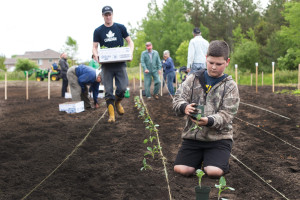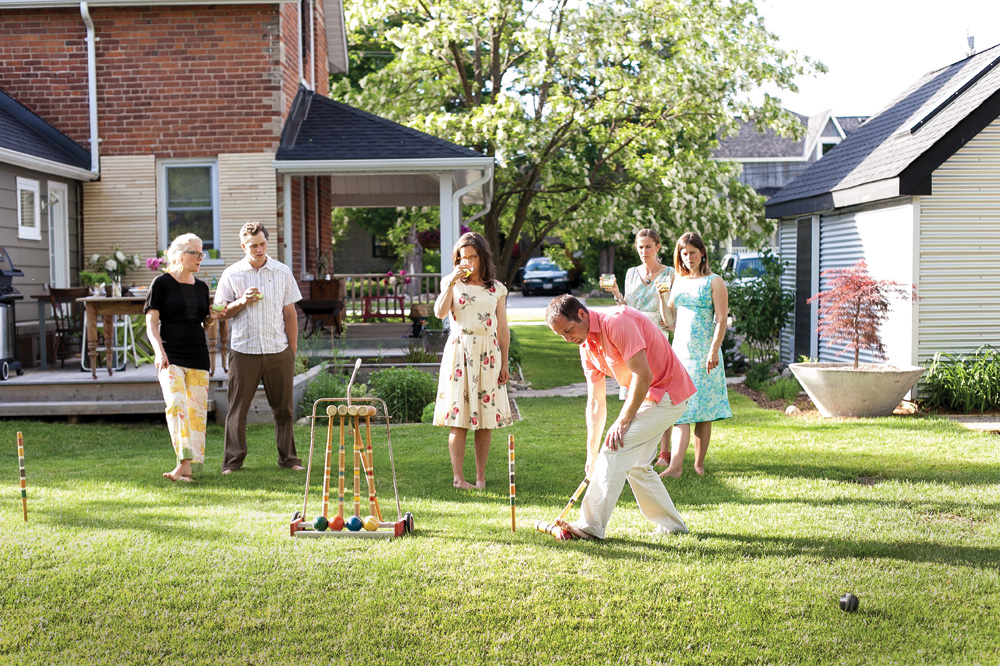Community gardens are popping up all over Southern Georgian Bay, growing fresh, local produce while enhancing and sustaining our communities
by Emily Worts ❧ photography by Richard Galloway
It’s Saturday morning – garbage collection day for Matt Code, co-owner of Free Spirit Gardens. But he isn’t after just any garbage; he’s on the hunt for potato peels, coffee grinds, wilted lettuce and other organic waste from Collingwood area restaurants. Code collects big blue garbage bins full of waste from Espresso Post, Pure and Café Chartreuse and shuttles them to the composting station at the Collingwood community garden, called the Cook Community Garden, located near the Lockhart subdivision. He heaves the 80-pound barrels from the back of his truck, onto his shoulder and into the four-bin compost system. Code is playing alchemist – nine months from now this waste will be super-rich compost and triple mix used for Free Spirit’s various garden initiatives.
Code has a passion for gardening and farming. Three years ago, after rallying friends with a shared vision of a more sustainable future to sit on his board of directors, he started Free Spirit Gardens as a not-for-profit enterprise.
“For us, as a company (Free Spirit Tours, which Code founded), we wanted to give back to the community,” says Code. “I have a love for teaching people on ways to contribute to a healthier lifestyle and a healthier planet. We want to be a catalyst in finding a sense of purpose in the community and how to help.”
Their main initiative is the Cook Garden, named after Ted Cook whose family donated the land, in partnership with Elephant Thoughts and the Environment Network of Collingwood. You will see Code and executive director, Kimberly Edwards along with various volunteers at the Collingwood Farmer’s Market selling fresh produce from the community garden while raising awareness, with all proceeds going back into their garden projects. The Cook Garden also grows for the Salvation Army food bank and last season donated 200 pounds of fresh vegetables. Free Spirit Gardens host dozens of gardening workshops throughout the year, they provide 10 by 15 foot rental plots, at two different locations, for $30 a season (with a $10 rebate for volunteering in the community plot) and design and build edible landscapes for private clients, again with all proceeds going back into the not for profit.
Community gardens are as diverse as the people who plant them and by keeping the definition of a community garden broad, you keep the effects broad. There are several ways a community garden can work: rental plots, family allotments, sharing backyard space, gardening in public spaces like school grounds, or gardening with neighbours on communal balconies. By the same token, community gardens are initiated for a variety of reasons: community food security, community building, community stewardship of public space or outdoor classrooms and demonstration gardens or simply learning the art of gardening, a lost skill set for so many of us. Whatever the reason for starting a community garden, the focus is inevitably on community, with the garden acting as a platform bringing people together through soil and seeds.
The idea of community gardens is not a novel one but rather an ancient concept, rooted in the philosophy of the commons. Victory gardens, popular during both world wars, were communal efforts that not only aided the war effort by supplementing food rations, but were considered civil morale boosters. Thirty years later the trend towards converting unused urban green space into community gardens really gained momentum with the ecology movement. No matter how you define community gardens, there is room in the garden for everyone. Gardens play a significant role in enhancing the physical, emotional and spiritual wellbeing of those who work in them and those who share in their bounty. On a communal level gardens contribute to healthy and socially sustainable communities.
In the Town of Wasaga Beach, a committee including the South Muskoka Health Unit, the Georgian Bay Health Team, the Environment Network and the Healthy Community Network spearheaded a community garden this past year. After a year of planning, 52 plots were dug on the corner of Fernbrook Drive and River Road. The 4-by-12-foot plots are accessible by transit, bike and foot – important criteria when deciding where to put the gardens. “We wanted to make it accessible to all. We are hoping new people come in and learn how to garden and take what they learn back to their own back yards,” says Gerry Reinders, manager of parks facility and recreation for Wasaga Beach.
The Town of Wasaga Beach Community Garden is in year one of a two-year pilot project and is already a success. All 52 plots were reserved before the season started. A wide spectrum of people including youth, seniors and every age group and demographic in between have rented plots this year, says Reinders.
“Even the staff at the municipal building rented one with food going to the food bank,” he notes. “Others are growing for the food bank as well and we have asked anyone with extra food to donate it.” The cost of a plot is $20, with a $30 deposit which is refunded at the end of the season if your plot has been well maintained.
Back at the Cook Garden, Collingwood Collegiate Institute (CCI) and Jean Vanier students help get the garden up and going, while teachers and Free Spirit Garden volunteers use the garden as a teaching tool. The Cook Garden is strategically situated between the two high schools, attracting participating youth who are increasingly concerned about the environment and their personal impacts on the planet. “A lot of them see the negative effects and can appreciate what we’re trying to share with them and are more engaged,” says Code. “The garden has inspired them.”
Michael Burgess, a 19-year-old Jean Vanier graduate, began his growing career as a volunteer for Free Spirit Gardens last spring. He was awarded a paid summer internship (courtesy of the Town of Collingwood) last summer, then spent time in a self-sustaining commune in Quebec in the early fall. Burgess went on to an international permaculture course in Portugal before coming home to Collingwood to start his own business, which involves growing food in three rental plots in the Cook Garden. He also sits on two local boards and has been accepted to Ryerson’s environmental and urban sustainability program for the fall. And it all started with getting his hands dirty in a community garden. “I saw a lot of the challenges we faced locally, especially in the garden,” says Burgess. “It’s much more than just gardening. It’s about philosophy.”
Burgess still volunteers in the garden and today he is hosting a workshop for Jean Vanier’s Geo Venture group. Two dozen students are turning compost into the soil of the Cook Garden. A handful of them take their lunch break in the garden and peruse Burgess’ collection of gardening books, sharing ideas and laughing. Just last year he was one of these students. Community gardens benefit all ages – from parents who want to introduce young children to gardening to older people who don’t have the space at home but want to grow again.
In Meaford it’s the students of the environmental class at Georgian Bay Secondary School (GBSS) who are keeping the area’s community garden consistently growing. Each spring they hold an annual plant sale, selling everything from tomatoes and pepper seedlings to ornamental plants and maple tree seedlings with proceeds going back into the GBSS garden and into the Meaford Farmer’s Market. This community garden and the adjacent greenhouse is a co-operative effort between students, the local food bank, Transition Meaford and gardeners from the community.
At the Beaver Valley Community School (BVCS), a 10-by-4 foot garden is active again and it is bringing high school and elementary students together to grow. The garden, which was started by teachers, and usually cared for in the summer by volunteers, had become neglected in the last few years. Like so many garden initiatives on school grounds it fell victim to lack of care in the summer months. “We have to find the inter-linkages so we can fill the holes when school is out,” says Ivan Chan, who now facilitates the school garden. “Youth groups, the senior demographic, Scouts groups, camps – the more we get people to take ownership and feel awesome by calling it ‘their’ garden – that’s what I’m looking for. It’s a bottom-up engagement process and the more interconnections the better. Everyone can only do so much. We want to empower others to take a role in enabling this garden.”
Chan sees these linkages as integral even when school is in. He organized a team of CCI’s Environmental Science and Outdoor Pursuits students to participate in a workshop at BVCS where they acted as big buddies to participating BVCS students. For the CCI students it’s a hands-on design activity which has them interacting with different age groups. For the BVCS kids they get to witness first- hand from their mentors that gardening is cool.
“I was surprised because the participating grade eights are off to high school so they won’t necessarily see the fruits of their labour,” says Chan of the enthusiasm of the BVCS students. “People have to understand they’re doing it for the earth and long term.” What goes into the garden at BVCS is decided by the students, but Chan encourages them to look at what will sustain over years, like edible perennials, trees and shrubs.
Beaver Valley Outreach programs including breakfast and lunch programs, the food bank and the Good Food Box are the primary beneficiaries of the garden. Even though there is great satisfaction in seeing the abundance growing every year it’s about so much more than production, says Chan. “It’s community building,” he says. “Community gardens mean more engagement and involvement. We have more of a sense of community and participation.”
On the other end of the spectrum is Earl Hoover of Stayner. For Hoover, 76, the Clearview Community Garden is all about production. He started the garden, an acre-plus plot at the south end of Stayner, in 2010 with a very clear objective. He wanted to grow fresh food for people who used the Stayner food bank.
“I just feel for those poor people who have to use the food bank because they are ill or have lost their jobs,” says Hoover. “I thought, if I could secure a chunk of land that could grow some veggies for these people, it would make a difference.”
Hoover and his wife, Joyce, are long-time supporters of the food bank and would often drop off cans of salmon and boxes of cereal. “We got acquainted with the director and we asked her if she ever got any fresh veggies,” recalls Hoover. “She said it was rare. People are dying to get fresh veggies.”
So Hoover decided to fill the need. He harvests, washes and delivers carrots, beets, potatoes, radish, peppers, Brussels sprouts, cabbage, lettuce and tomatoes, enough to fill his SUV twice a week in peak season, before the food bank doors open at 1 p.m. “The veggies are picked within four hours of drop-off. You can’t get it much fresher than that,” he says. The garden is ambitious and produces more than the food bank can use on some days. From the May long weekend into the dog days of summer when the harvest is mature, it is almost a full-time project.
“We had beans coming out our ears last year. One day we picked seven milk crates plus five baskets,” recounts Hoover. Whatever produce is left over at the food bank and can’t be saved or preserved is sold on a table outside Hoover’s house, with all proceeds going back into the garden. The community garden doesn’t have much of a bankroll, but it has been gifted tools, hose and seedlings in years past. The major challenge Hoover faces each year is finding enough hands to work the land. “We have been really fighting for consistent personnel over the years and it’s been a struggle,” says Hoover. “Two or three of us are 100 per cent there and there are a couple of women, in their seventies, who have come for the last two years and we can count on them like you count on a clock to keep ticking.”
But the garden demands more. “Three weeks after planting we need consistent help. If we had six people offering two to three hours a week, one hour at a time, that would be super,” says Hoover. Hearing the calls for help from the Clearview Community Garden and other local organizations encouraged Clearview’s deputy mayor Alicia Savage to go after funding from the Ontario Trillium Foundation. In order to do that she started dreaming of a collaborative. “So many groups came to mind, each with their own significant barrier or struggle, but not big enough to attract support,” says Savage. “I needed to find synergies where one group can provide what another doesn’t have.”
This collaborative included the Clearview Community Garden along with the Clearview/Stayner Food Bank, The Door Youth Centre, Stayner Chamber of Commerce and the Stayner Garden Club – groups that all faced challenges with volunteerism and infrastructure. In early April the PARC (Partnering, Advancing, Resourcing, Community) project, which also includes the Township of Clearview, was granted over $300,000 over four years by the Ontario Trillium Foundation.
An integral part of the project is the creation of a consistent volunteer base, including youth, and employment for post-secondary students interested in agriculture, agri-tourism, recreation and social work. The funds will allow the groups to hire and share two summer students this year, three summer students in year two and four students in years three and four. “Most youth want to be involved in something meaningful and the opportunity to pursue interests,” says Savage.
Part of the grant will go towards a tractor, plow and storage shed for the community garden and more refrigeration for fresh produce at the food bank. And because the community garden sits on land now approved for development, the PARC project will address the security of the garden by moving it to a new location over the period of the project.
“We want the garden on municipal land with full service, guaranteeing its longevity,” says Savage. The new plot – whose location Savage would not disclose – will be linked to the community trail system and will be integrated with future plans for recreation. “We want to protect it and make sure it always has a place in an area with access (road and pathways) and access to water,” says Savage. “Clearly the municipality is so supportive. We want to ensure it always has a place to continue.” It’s amazing to see what can come out of a community garden. Beyond fresh food for all who want it, the garden can lead to engagement, empowerment and even employment.
Every fall we celebrate Thanksgiving with the Horn of Plenty symbolizing a successful bounty and full bellies. Back in the Cook Garden, Matt Code, along with his team of staff, volunteers and gardeners, celebrates with a September potluck of thanks. Surrounded by hand-made twig trellises heavy with beans, tall colourful clumps of rainbow chard and waving stalks of corn, dozens of people gather around picnic tables, hand built from reclaimed wood, sharing tales of trial and error in the garden and showcasing their garden triumphs.
“The goal is to use things grown in the garden and to tell your story,” says Code of the end of season potluck. “We are creating a network of like-minded people to share and grow together.” And this network just keeps growing. Last year 11 people rented plots and 20 shared meals at the potluck. This season 31 people have already signed up for plots.
To his never ending to-do list, Code now has to add, “build more picnic tables.” The concept of the community garden is not new and in fact probably carries on unnoticed and informally as neighbours share backyard space, church groups beautify their green space and grandkids help their grandparents weed the family plot. But in this time of increased awareness of where our food comes from, combined with a need to strengthen our community relationships, a desire to be healthier in mind, body and spirit, and a call for stewardship of our communal spaces, the community garden seems like an incredible place to begin the journey of transitioning our towns’ under-used green spaces into gardens where we can all grow, together.















